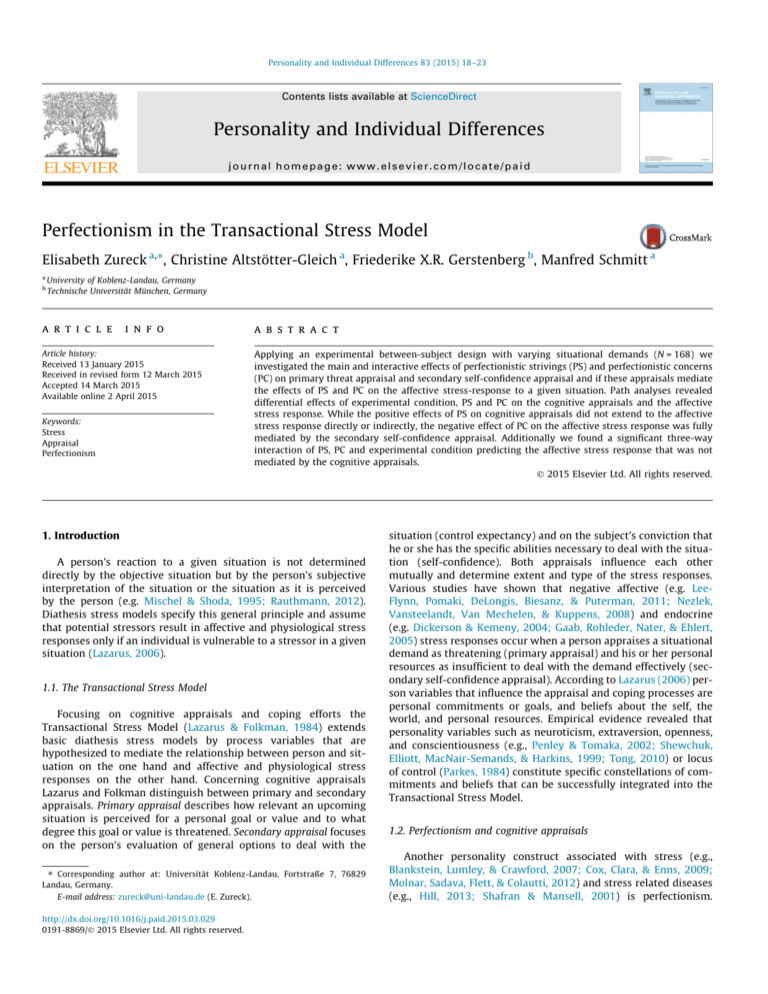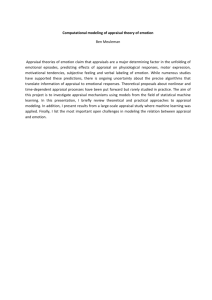
Personality and Individual Differences 83 (2015) 18–23
Contents lists available at ScienceDirect
Personality and Individual Differences
journal homepage: www.elsevier.com/locate/paid
Perfectionism in the Transactional Stress Model
Elisabeth Zureck a,⇑, Christine Altstötter-Gleich a, Friederike X.R. Gerstenberg b, Manfred Schmitt a
a
b
University of Koblenz-Landau, Germany
Technische Universität München, Germany
a r t i c l e
i n f o
Article history:
Received 13 January 2015
Received in revised form 12 March 2015
Accepted 14 March 2015
Available online 2 April 2015
Keywords:
Stress
Appraisal
Perfectionism
a b s t r a c t
Applying an experimental between-subject design with varying situational demands (N = 168) we
investigated the main and interactive effects of perfectionistic strivings (PS) and perfectionistic concerns
(PC) on primary threat appraisal and secondary self-confidence appraisal and if these appraisals mediate
the effects of PS and PC on the affective stress-response to a given situation. Path analyses revealed
differential effects of experimental condition, PS and PC on the cognitive appraisals and the affective
stress response. While the positive effects of PS on cognitive appraisals did not extend to the affective
stress response directly or indirectly, the negative effect of PC on the affective stress response was fully
mediated by the secondary self-confidence appraisal. Additionally we found a significant three-way
interaction of PS, PC and experimental condition predicting the affective stress response that was not
mediated by the cognitive appraisals.
Ó 2015 Elsevier Ltd. All rights reserved.
1. Introduction
A person’s reaction to a given situation is not determined
directly by the objective situation but by the person’s subjective
interpretation of the situation or the situation as it is perceived
by the person (e.g. Mischel & Shoda, 1995; Rauthmann, 2012).
Diathesis stress models specify this general principle and assume
that potential stressors result in affective and physiological stress
responses only if an individual is vulnerable to a stressor in a given
situation (Lazarus, 2006).
1.1. The Transactional Stress Model
Focusing on cognitive appraisals and coping efforts the
Transactional Stress Model (Lazarus & Folkman, 1984) extends
basic diathesis stress models by process variables that are
hypothesized to mediate the relationship between person and situation on the one hand and affective and physiological stress
responses on the other hand. Concerning cognitive appraisals
Lazarus and Folkman distinguish between primary and secondary
appraisals. Primary appraisal describes how relevant an upcoming
situation is perceived for a personal goal or value and to what
degree this goal or value is threatened. Secondary appraisal focuses
on the person’s evaluation of general options to deal with the
⇑ Corresponding author at: Universität Koblenz-Landau, Fortstraße 7, 76829
Landau, Germany.
E-mail address: zureck@uni-landau.de (E. Zureck).
http://dx.doi.org/10.1016/j.paid.2015.03.029
0191-8869/Ó 2015 Elsevier Ltd. All rights reserved.
situation (control expectancy) and on the subject’s conviction that
he or she has the specific abilities necessary to deal with the situation (self-confidence). Both appraisals influence each other
mutually and determine extent and type of the stress responses.
Various studies have shown that negative affective (e.g. LeeFlynn, Pomaki, DeLongis, Biesanz, & Puterman, 2011; Nezlek,
Vansteelandt, Van Mechelen, & Kuppens, 2008) and endocrine
(e.g. Dickerson & Kemeny, 2004; Gaab, Rohleder, Nater, & Ehlert,
2005) stress responses occur when a person appraises a situational
demand as threatening (primary appraisal) and his or her personal
resources as insufficient to deal with the demand effectively (secondary self-confidence appraisal). According to Lazarus (2006) person variables that influence the appraisal and coping processes are
personal commitments or goals, and beliefs about the self, the
world, and personal resources. Empirical evidence revealed that
personality variables such as neuroticism, extraversion, openness,
and conscientiousness (e.g., Penley & Tomaka, 2002; Shewchuk,
Elliott, MacNair-Semands, & Harkins, 1999; Tong, 2010) or locus
of control (Parkes, 1984) constitute specific constellations of commitments and beliefs that can be successfully integrated into the
Transactional Stress Model.
1.2. Perfectionism and cognitive appraisals
Another personality construct associated with stress (e.g.,
Blankstein, Lumley, & Crawford, 2007; Cox, Clara, & Enns, 2009;
Molnar, Sadava, Flett, & Colautti, 2012) and stress related diseases
(e.g., Hill, 2013; Shafran & Mansell, 2001) is perfectionism.
E. Zureck et al. / Personality and Individual Differences 83 (2015) 18–23
Perfectionism is a multi-facet construct that can be summarized as
setting of and striving for extremely high standards (perfectionistic
strivings, PS) combined with a more or less critical evaluation of
one’s own behavior and concerns about the consequences of not
living up one’s standards (perfectionistic concerns, PC) (see
Stoeber & Otto, 2006 for an overview). Hewitt and Flett (2002)
outline the central role of stress in perfectionism research stating
that ‘‘perfectionistic behavior is associated with psychopathology
through its association with and influence on stress’’ (p. 257).
While the assumption that stress mediates the effects of perfectionism on various indices of maladjustment is well documented
(especially for the PC-dimension) (e.g., Chang, Watkins, & Banks,
2004; Molnar et al., 2012; Tashman, Tenenbaum, & Eklund,
2010), processes that mediate the influence of perfectionism on
stress are not well explored. An integration of perfectionism as personality variable into the Transactional Stress Model, providing
such process assumptions, is a promising approach to close this
gap.
The main concerns of the present study are effects of PS and PC
on primary and secondary appraisals and if these appraisals mediate the effects of PS and PC on the stress-experience in a given situation. The definition of perfectionism indicates that PS and PC
reflect specific commitments and beliefs that might be readily integrated into the Transactional Stress Model to explain perfectionism-specific
stress-appraisals
and
-reactions.
More
specifically, the personal commitment to extremely high standards
(PS) should generally increase the perceived relevance but not
threat of a given performance situation (primary appraisal), and
the commitment to the active striving for those standards might
be associated with higher self-confidence (secondary appraisal).
In contrast, the belief that even small deviations from the ideal
are extremely detrimental (PC) should increase the perceived
threat in a situation (primary appraisal). Additionally, this overly
critical self-evaluation should be associated with a lower self-confidence (secondary appraisal). Thus, high PC entail negative primary and secondary appraisals that in turn lead to negative
psychological outcomes, whereas high PS might be regarded as a
‘‘healthy pursuit of excellence’’ (Shafran, Cooper, & Fairburn,
2002, p. 778).
There are many studies on the relationship between perfectionism and variables that might be subsumed under primary and secondary appraisal, such as threat and its affective and motivational
indicators (e.g., Bieling, Israeli, & Antony, 2004; DiBartolo & Varner,
2012; Stoeber & Rennert, 2008), self-esteem, self-efficacy, perceived self-control and locus of control (e.g., Achtziger & Bayer,
2013; Blankstein et al., 2007; Lo & Abbott, 2013; Periasamy &
Ashby, 2002). While these findings provide initial support for an
integration of perfectionism into the Transactional Stress Model,
most of these studies did not assess indicators of anticipatory primary and secondary appraisals as process variables that might
explain associations of PS and PC with stress-responses in a concrete situation. Achtziger and Bayer (2013), for example, found that
the negative effect of PS on perceived stress in the last three month
was fully mediated by perceived self-control, whereas the positive
effect of PC was partially mediated by lowered self-control. While
successfully testing a mediation model via a potential indicator of
secondary appraisal, this study did not assess anticipatory primary
and secondary appraisals in a concrete situation. Wirtz et al.
(2007), on the other hand, found that PC was not only associated
with an increased endocrine stress reaction to a socio-evaluative
stress task (Trier Social Stress Test, TSST; Kirschbaum, Pirke, &
Hellhammer, 1993) but also to higher trait anxiety, higher primary
threat appraisal, and to lower secondary self-confidence appraisal.
Although this study assessed anticipatory appraisals in a standardized situation, this study did neither test for differential effects of
PS nor for mediating effects of the appraisal variables.
19
To our knowledge, this is the first study to integrate specific
facets of PS and PC into the Transactional Stress Model. Thereby
the first aim of the present study was to investigate primary threat
appraisal and secondary self-confidence appraisal as potential
mediators between perfectionism and the affective stress-response. We assumed that
(1) PC is positively related to the affective stress response in a
performance situation, and this relationship is mediated by
primary threat and secondary self-confidence appraisals.
(2) PS is negatively related to the affective stress response in a
performance situation and this relationship is mediated by
primary threat and secondary self-confidence appraisals.
The second aim of the study was to extend prior research by
investigating interactive effects of PS and PC. Group-based models
of perfectionism (e.g., Gaudreau & Thompson, 2010; Stoeber &
Otto, 2006) call for the inclusion of interactive effects of PS and
PC besides just controlling for the shared variance of both dimensions in multiple regression analyses.
The third aim of our study was to investigate the main and
interactive effects of PS and PC under two experimental conditions
of high vs. low in situational demand (cf. Zureck, Altstötter-Gleich,
Wolf, & Brand, 2014) in order to explore two assumptions of
Hewitt and Flett (2002) on perfectionism as vulnerability factor:
The perfectionist’s (PC’s) high sensitivity to deviations from an
ideal performance should ‘‘turn a relatively benign situation into
a stressful encounter’’ (p. 262) and positive effects of PS have to
be challenged by a situation in which standards cannot be reached.
2. Method
2.1. Participants
A sample of N = 168 students participated in the study
(Mage = 21.9, SDage = 3.5; 68% female; 70 psychology, 98 nonpsychology).
2.2. Procedure
In order to control for baseline group differences, participants
completed a perfectionism questionnaire (see description below)
before the actual testing session and were parallelized according
to their scores of PS and PC. Using a between subjects design, participants were assigned to a highly demanding (TSST, n = 85) or a less
demanding (Placebo, n = 83) experimental condition. The two
groups were comparable with regard to age, gender, and major distribution. For the experimental manipulation of situational
demand we applied the standard protocol of the TSST introduced
by Kirschbaum et al. (1993) and its Placebo version adopted by
Het, Rohleder, Schoofs, Kirschbaum, and Wolf (2009). The TSST
consists of a preparation time (5 min), a simulated job interview
(5 min), and a highly demanding arithmetic task (5 min) in front
of a two-person committee, a video-camera and a microphone.
This procedure is effective in inducing endocrine and affective
stress responses (see Kirschbaum et al., 1993). The Placebo-TSST
consists of a preparation time (5 min), a talk about a recent leisure
experience (5 min), and a less demanding arithmetic task (5 min)
while alone in the experimental room. This procedure has proved
to be an adequate control condition (see Het et al., 2009).
Values of the affective stress state were assessed immediately
before (baseline) and after (post-stressor) the experimental manipulation. All items were presented in German. At the end of each
individual testing session participants were fully debriefed.







